“It’s got this otherwordly vibe about it, it had this really great energy, and I wanted to have a record that lived up to that energy!”. Chester Bennington, on why he named Linkin Park’s Second Studio Album (Meteora) after this unique rock formation in Greece.
Deep Blue Sea, vast stretched- exquisitely coloured volcanic beaches, romantic islands; and a few rebel slogans here and there on the city walls; sums up the totality of Greece for most tourists and travellers. But Greece has a well kept secret; to discover that one has to look beyond the Aegean Sea.
How we came across Magical Meteora?
It’s funny how we discover the most magical things in life, by chance.
We were wrapping up an episode where the backdrop of the Eyrie’s Castle in the sky caught my attention. It was the castle above the clouds where Tyrion had his cell in the sky. One of the most eerily striking scenery in the entire series of ‘GOT’; and I simply could not erase it from my memory. “Must be CGI”, we murmured.

Awe Inspiring Greek Monasteries perched amidst lofty elevations! Indeed a Spectacle!!!
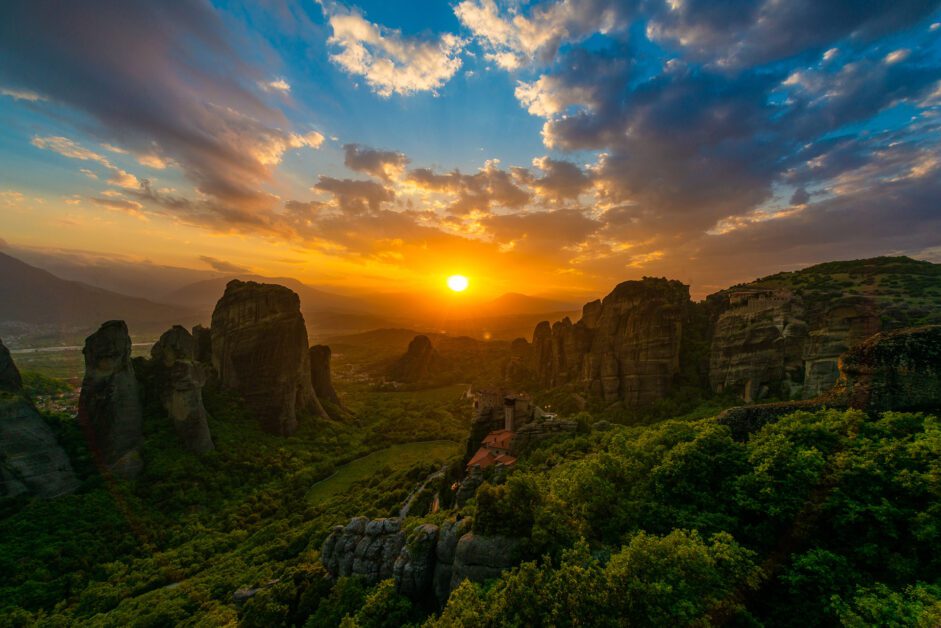

Twilight Hours have a Special Charm! Just look at the Sun-Rays though. . .
But then location credits towards the end gave away the fact that such an epic location exists in reality. It goes by the name, “Meteora”, and is located towards North of Greece. We were scheduled to visit Greece the next month and we had our ‘planned itinerary’ in place. We made some reshuffling to accommodate this magical land in our travel plan.
Meteora At a Glance
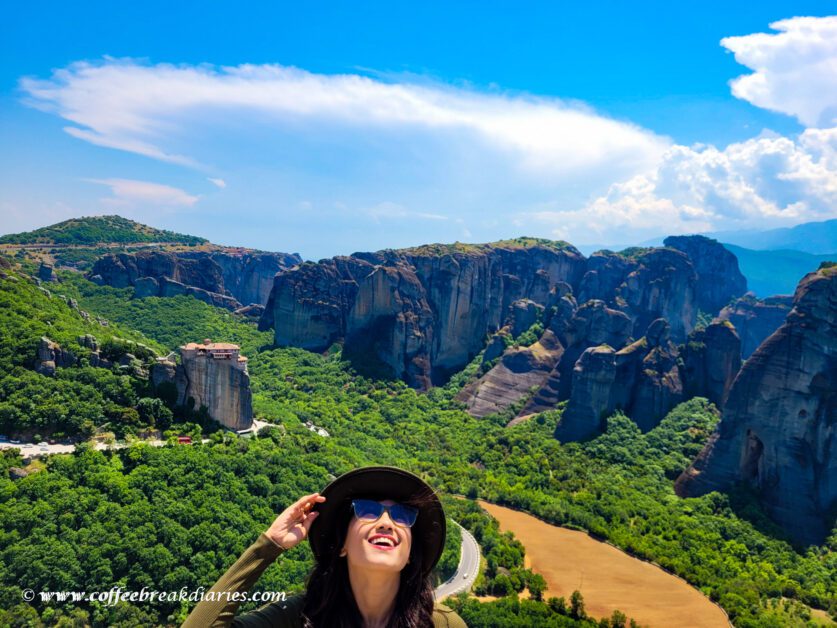

Soaking in the Sun and also the Reality of actually experiencing this Magical Place!
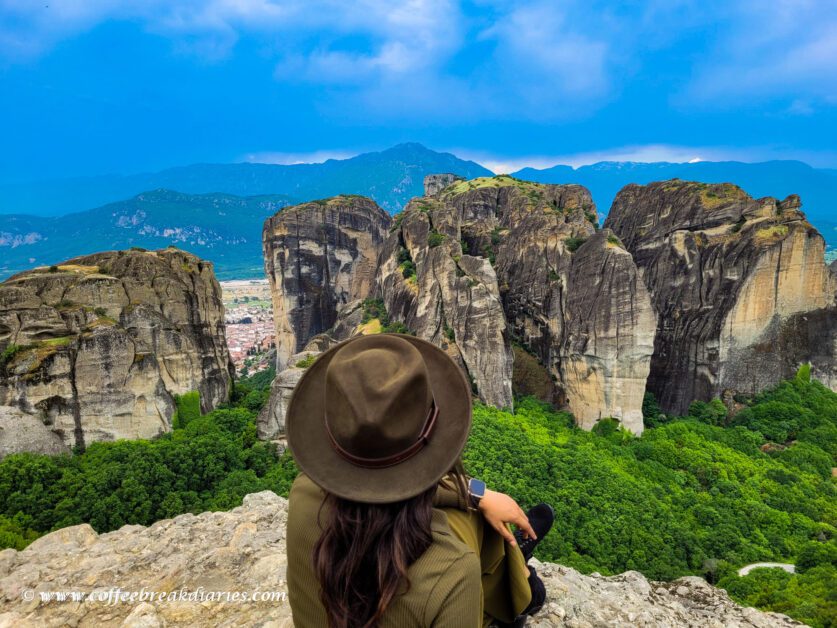

Can you Beat these Views? Perfection. . .
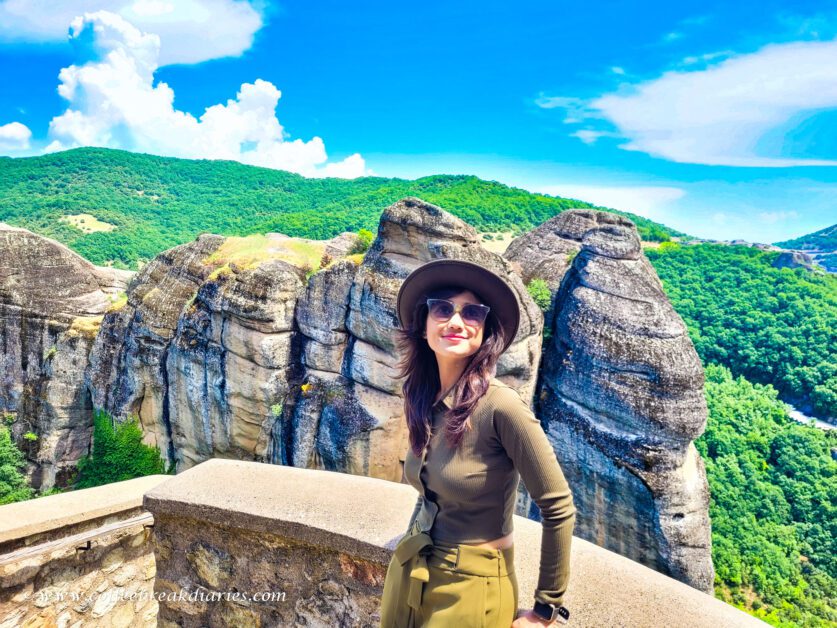





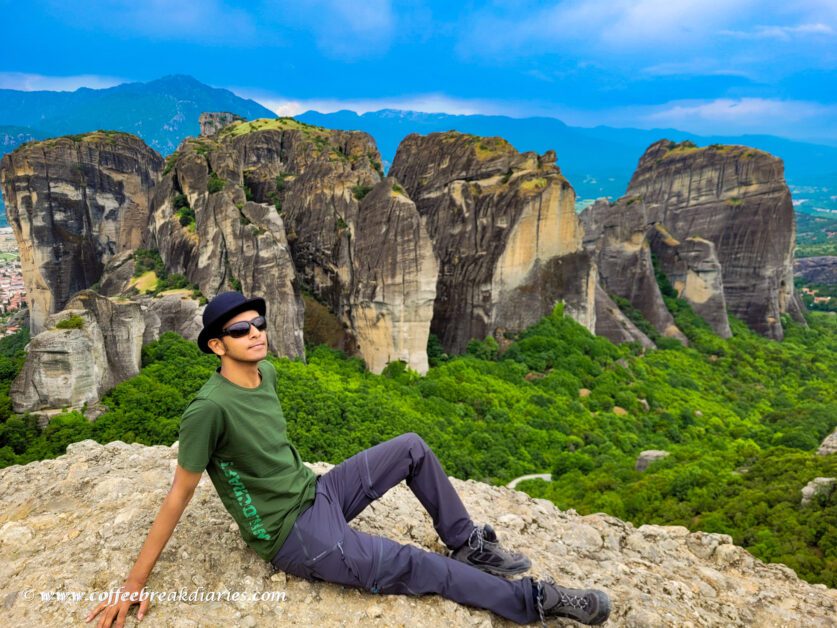

And this is how Maddy sits on the Edge!
Lofty Elevated Rock formations reaching heights of more than 300 metres from the ground, a vast expanse scenery with cotton candy clouds playing hide and seek in the backdrop. And add to that well-crafted, beautifully ornate monastries perched on top of the bizzare formations. A mysterious air surrounding the environ – each aspect of the mystical land baffles the human mind even today. That, my friend, is ‘Meteora at a glance’.
History of Meteora – A Geological and Evolutionary Perspective
Meteora belongs to the most important monastic communities of Christianity’s Greek-Orthodox dogma; and was always regarded as a sacred place of worship. That’s why they’re often referred to ‘holy Meteora’.


How these Rock Elevations were formed is still unknown! Meteora is indeed a mystery. . .
The bizarre-looking vertical rock formations of Meteora were always a place hard to approach and familiar just to locals. The fact that it is not mentioned in ancient Greek Mythology, despite our knowledge about the people that used to reside in the area, proves the inaccessibility of the location and adds to its mystic nature.
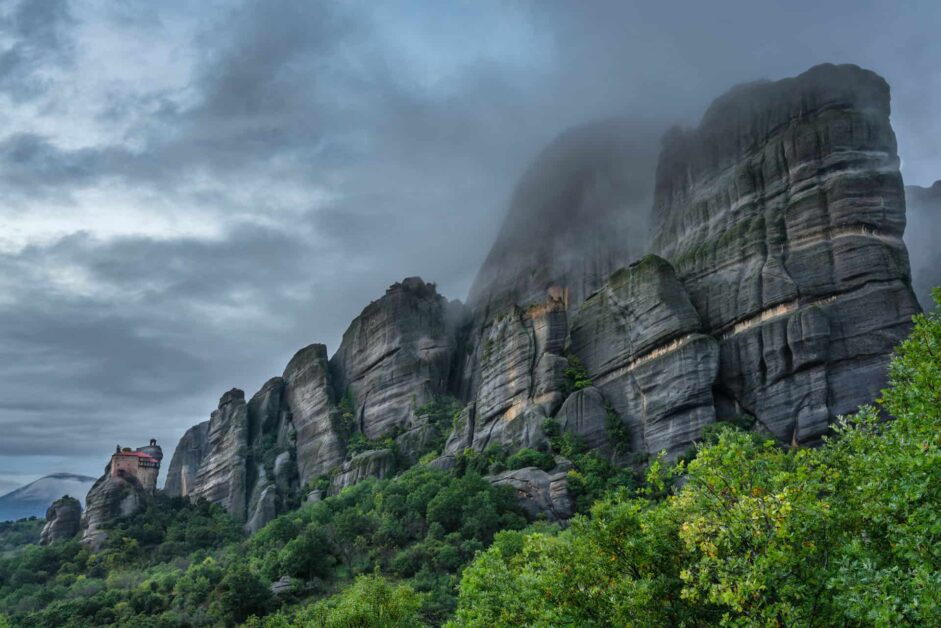

One Moment there is Sunshine on your face and the Next Moment a Thick blanket of Clouds Surround Meteora! Eerie much?
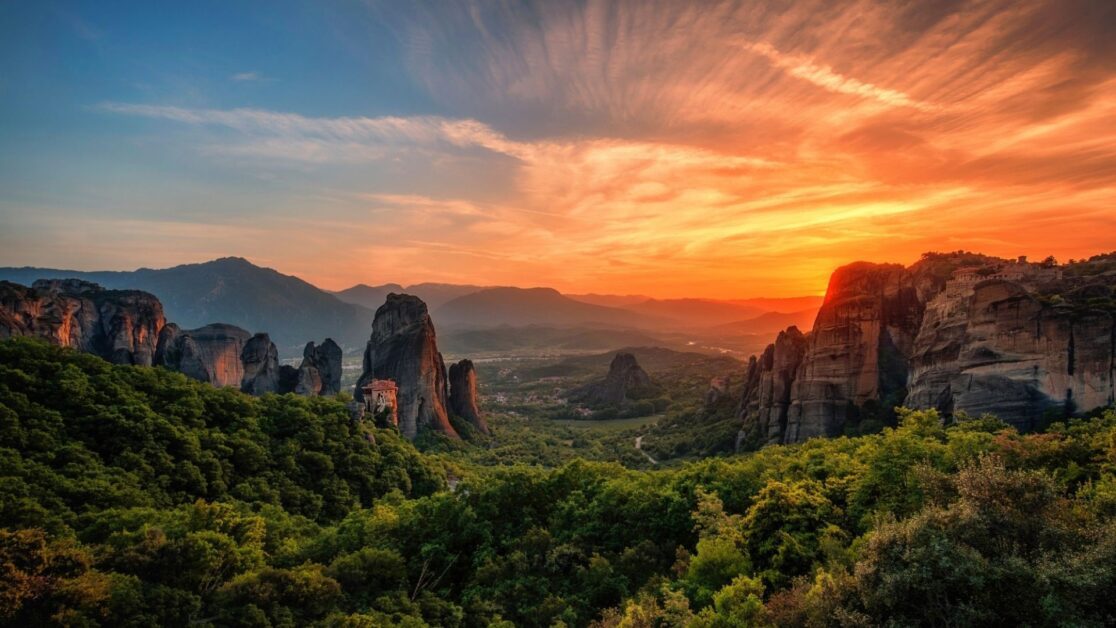

Grand Sunset Views!
Since Byzantine times, these rock formations of Meteora were chosen by monks as an ascetic retreat; mainly due to their inaccessibility, suitable for their isolation from the secular world; and therefore, facilitating their focus on their quest for God.
The formation of bizarre Meteora Rocks dates back to 60 million years ago during the Paleogene period.
Geologists reveal this piece of finding in utter marvel. Because contrary to popular belief, Meteora formations do not fit into the classic case of a volcanic plug, magma cooling and hardening; instead, they mostly consist of sandstones and conglomerates.
During excavations in the cave, archaeologists found evidence that shed more light on specific problematic time periods of human evolution. Namely, they discovered evidence regarding the replacement of the Neanderthal occupation with the Homo Sapiens, and evidence of the transitional period from hunter-gatherers to farmers after the end of the last Ice Age. The earliest findings of the cave date back some 130000 years ago! Now, that’s some piece of news, isn’t it?
How to Get to Meteora?
Unless you want to go trekking in the hills of Meteora, it is best to include Meteora as a guided day’s tour. That way you get to learn about the history of the monasteries and the artifacts. Some might argue that going in groups might devoid them of seclusion that they wish to seek there. Well, truth be told, there would still be enough space for everyone to isolate and meditate. Still, should you wish for absolute isolation, you can book a stay near Kalambaka and enjoy the wee hours of sunrise and sunset amidst the lofty elevations.
We were based in Athens, and trains are the most convenient means of public transport there. So this is the itinerary we planned
We took the Metro to the Syntagma Square from Athens and then onwards to Larissa. We boarded our pre-booked train from the Larissa Station and continued our journey to Kalambaka. Kalambaka has its own train station and is connected to Larissa Train Station, which is the central railway station in Athens.
Read on to get a detailed idea:
Take the Metro Red Line to Larissa Station. If you’re coming from Syntagma, it should be easy because Syntagma is also along Red Line, just four stations away. Fare: €1.40. If you’re coming from Athens Airport, you must first take the Blue Line to Syntagma Station and then transfer to Red Line to Larissa Station. Fare: €10.
At Larissa Station, board the train to Kalambaka. There is only one direct train per day, scheduled to leave Athens at 08:20am and arrive in Kalambaka at 01:18pm. Fare: €18.3 – €25.6. If that’s not an option for you, you may travel to Paleofarsalos first then switch to another train bound for Kalampaka. See the schedule below.
Alight at Kalambaka Station. This is the last stop.
From Kalambaka Station, take the tour bus to Meteora. From March to November, there’s a bus leaving Kalambaka at 9am, 12 noon, and 3pm. Fare: €1.80 one-way, €3.30 round trip. No public buses in winter. You can either take a cab instead or just hike, which is great and very scenic.
Meteora Monastery Expedition
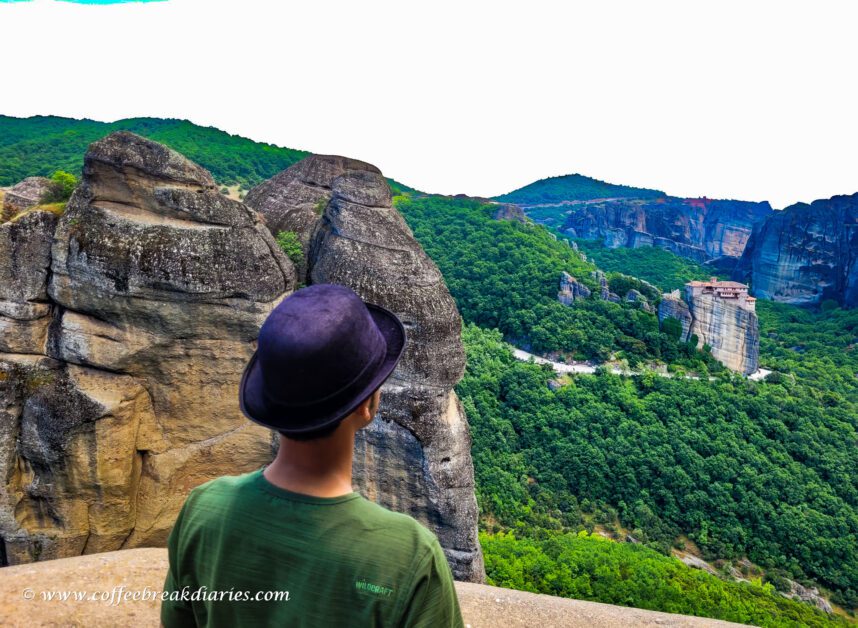

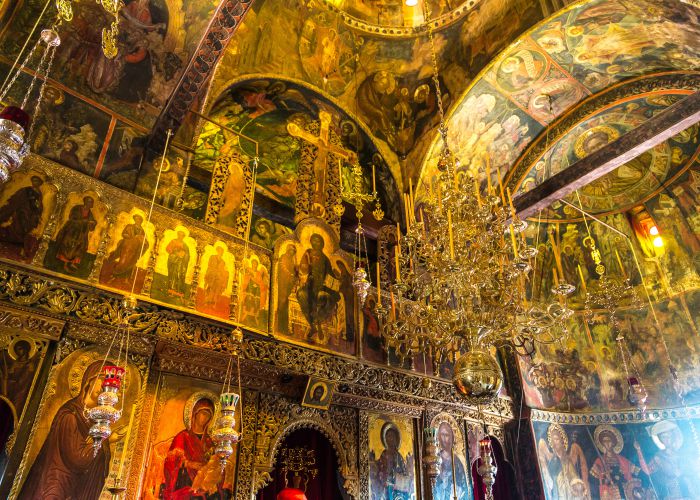

The Dazzling Monastery Interiors!!! What Arts and Craftmanship. . .
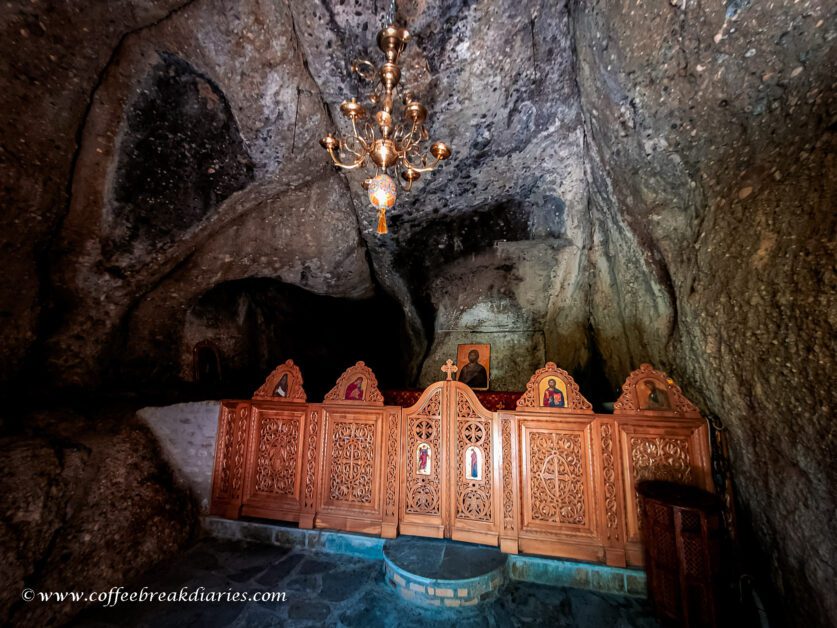

Ode to the Holy Spirit!
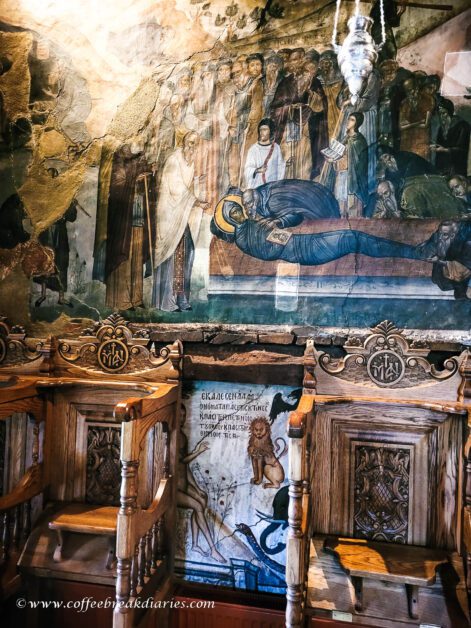

A Throne, A Casket and a Message. . .
Ever since the first hermits took shelter in its caves and narrow fissures on the walls of the rocky towers, these sandstone columns have seen 24 Eastern Orthodox monasteries, making it one of the faith’s most important sites, second only to Mt. Athos. Because the monasteries were built on the summit of these rocks, they offer complete isolation. For most of its history, the only way to reach them were by long ladders, ropes, and nets.
Today, only six of these monasteries remain standing, inscribed in the UNESCO World Heritage List.
The Meteora Monasteries is a reservoir of important examples of Byzantine Architecture and bear the splendour of priceless murals, icons and art works, covering a wide timespan of the evoltution of Byzantine iconography.
Meteora Monasteries – A Sneak Peek
a. The Holy Monastery of Great Meteoron: This was our first stop and was unarguably the biggest and the oldest of the six remaining monasteries. It had three chapels and stored within them were the treasure house of library books and manuscripts.
b. Varlaam Monastery: This Monastery is a museum of adorned with impeccable religious icons. The art inscriptions on the walls and the erected artforms in the form of statues and paintings stole our breathe.
c. The Roussanou Monastery is arguably among the most impressive but lower than the rest, thus more accessible along with other monasteries, such as the St. Stephen Monastery and the monastery of St. Nikolas. The St Stephen Monastery is the only monastery that has no steps.
d. The Holy Trinity Monastery: For us, this monastery was the hardest to reach but worth every ounce of effort required! The spectacular 360 degrees panned view of the jarred rock formations from the monastery was truly phenomenal.
Meteora Monastery – Timings and Rules
All monasteries above charge a €3 entrance fee. Kids 12 and below can enter for free. The timings vary every season and every year. So make sure to check their official website for the latest timings.
Also do dress modestly whilst visiting the monasteries. Shorts and Sleeveless are a strict no no. Girls/Women are required to wear a long skirt before entering. Some monastery provide it for free while some charge €3 for a measley piece of cloth.
Meteora Invasions
Legend has it, that the first inhabitants of Meteora climbed the colossal pillars with their bare hands and feet, despite the ruthless weather conditions. For hundreds of years following, the only means of transferring goods up or down was to use nets and rope and haul them up! Although maintaining a living close to the sky may have been treacherous at the time, it also provided safety from invaders and raiders.
Meteora was never immune to attacks from foreign invaders.
During World War II, the region of Meteora was bombarded, leaving behind ruined monasteries and resulting in a wave of plundering of the valuable and holy relics of those monastic complexes. Furthermore, it is believed that during the Turkish occupation, the monasteries of Meteora safeguarded the Hellenic culture and traditions as they became religious, artistic, and academic centers. Thus, if it were not for the monasteries, modern Greece would look far more like Turkey as her roots would have been long forgotten.
Meteora – The Conclusion
The exquisite monasteries of Meteora perched on top of these mammoth pedestals are a result of hermit monks’ inspiration to be closer to god, and once you get to the top, you will understand why. The feeling you get looking over one of nature’s grandest views could be easily interpreted as divine. Pictures truly cannot do Meteora justice. The smells, sounds, and fresh breeze all contribute to the magical feeling you get at the crown of the rocks.
The first hermits arrived in hopes of finding seclusion and spiritual peace. Centuries later, Meteora is now swarmed by tourists, gawking at the beauty of the surrounding landscape and splendor of its monastic tradition. But even amid the the busyness within and around the monasteries, it is apparent why, of all places, it is here that the first occupants chose to dwell.
It takes little imagination to see that Meteora, at least back in the day, was as serene as slumber and as solemn as a prayer.

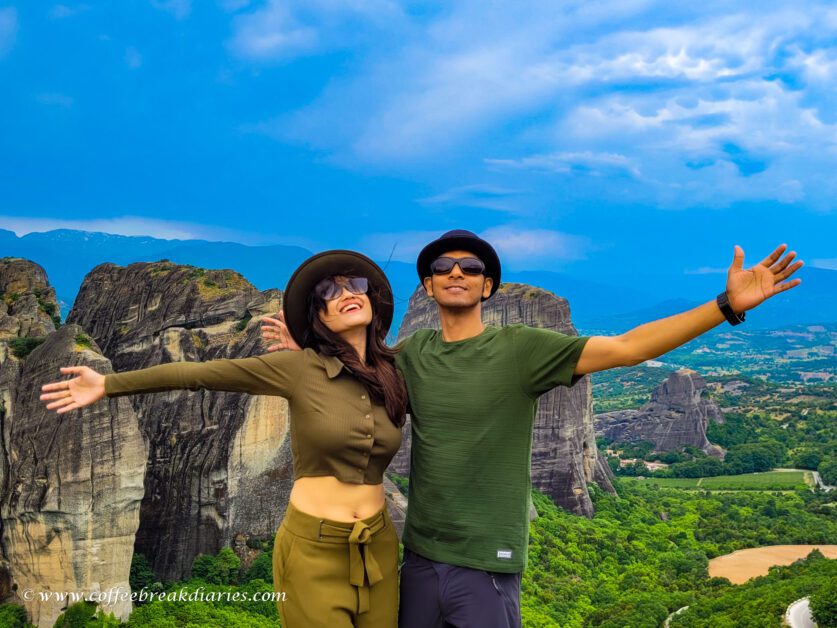
3 thoughts on “Mythical Mystical Meteora, Greece – A Day Trip”
wow, this place is amazing. I like your guide is easy to understand and will use it when I go there. Never been to Greece before! Thank you for sharing!
Nice article 👍
Good hold on the topic.
The place seems really awesome! You guys have described it so well with such amazing pictures. I will certainly plan a trip to Meteora very soon!